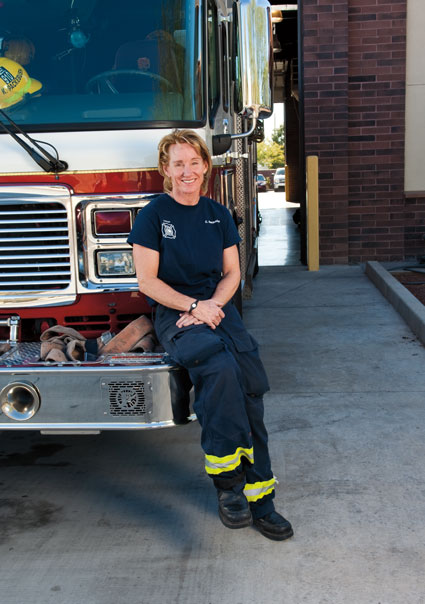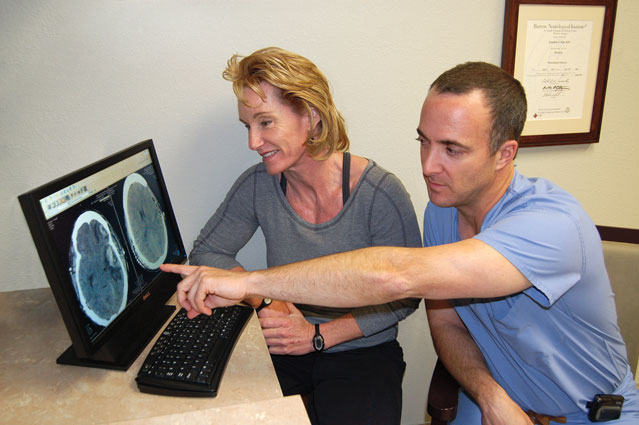Find out why this professional rescuer needed rescuing, and how she now reaches out to help others recover.

Capt. Crystal Rezzonico is back at work at Phoenix Fire Station 60 doing what she loves.
It was just another day in the office for 49-year-old Phoenix Fire Capt. Crystal Rezzonico when – in a split second – she was transformed from a highly trained professional rescuer to a critically injured patient in dire need of being rescued.
“If something like this had to happen,” she said, “I’m so thankful it happened while I was with my crew, just moments away from the John C. Lincoln Trauma Center. I was really blessed.” She credits her life and her recovery to being in the right place with the right people nearby.
On that day in 2009, the 21-year Fire Department veteran had been doing what she loved, rushing with her crew, sirens blaring, emergency lights blazing, to the aid of others in trouble.
She was belted into in her “office,” the bright red fire engine No. 910 from Station 60, when it was hit. A midsized sedan, traveling almost 70 mph, ran a red light near the Interstate 17 freeway overpass on Dunlap Avenue and hit her passenger door, impaling itself nearly four feet into the massive truck.
The collision forced the fire engine into oncoming lanes of traffic, causing it to strike several vehicles. Rezzonico was one of 14 people injured in the resulting eight-vehicle collision.
The impact was so explosive that it ripped Rezzonico from her seatbelt and ejected her into the air. She landed headfirst in the road, cracking her skull, crushing both sides of her head and also breaking both ankles. But her feet were the least of her worries, as her crew rendered emergency care and rushed her to the John C. Lincoln North Mountain Hospital Level I Trauma Center, where doctors focused on her serious head and brain injuries.
Trauma surgeon Steven Gale, MD, remembered she developed epidural, subdural and subarachnoid hematomas – blood that pooled and clotted at all levels inside her fractured skull. Pressure from her skull injuries dangerously depressed her brainstem, which controls essential automatic functions such as breathing.
Five separate brain surgeries were required to repair Rezzonico’s injuries. For nearly two weeks, she was in a coma in critical condition while her neurosurgeon, Jonathan Hott, MD, remained unsure whether she would live, much less “return to a happy place in her life.”
She choked up when thinking how her friends and family were told at the hospital to say their final goodbyes. “But I wasn't ready to go,” Rezzonico said. She fought back and finally awoke.
Although her sister tells her she was awake and interacting with hospital staff and visitors, she doesn’t remember her weeks in Intensive Care at John C. Lincoln. Her first coherent memories only go back to the extended care facility where she was transferred after graduating from Intensive Care at North Mountain. She was told she’d have to learn to adjust to limitations caused by her trauma, limitations she would not be able to overcome.
Rezzonico was determined to prove she could indeed again be independent and go back to work on her fire truck.
“I did have a lot to prove, to a lot of different people,” she said. “Head injuries scare people; they’re a legitimate concern, because no two are the same. I understand why my employers were hesitant to think I would, could or should come back to work.”
It took a while to convince them. “My sister quit her job for almost a year to take care of me,” Rezzonico said. “I don’t remember a lot from the early days after my trauma, but my family went through hell.”
Yet Rezzonico never lost hope, never gave up, even while persevering through “miserable” physical rehabilitation. Eventually, one year and two weeks after the crash, Rezzonico returned to work at Phoenix Fire, first for just two hours a day and then gradually increasing the number of hours she could work at any given stretch.

“Considering her injuries, she did very well,” Dr. Gale commented. “She’s incredible, and I was very pleased with her progress, very glad she’s alive.”
Rezzonico, too, is glad to be alive, but perhaps in a different way than before her trauma.
“I have changed,” she said. “I have much more interaction with patients. My crew calls me ‘Care Bear’ now, because I really want to help people. I spend a lot of time, on and off duty, talking to patients with head injuries, telling them I was where they are, with my head shaved, unable to function. And just as I got my life back, they can, too.
“I love doing that,” she said. “It’s what I believe I was left here to do.”
Please visit www.jonathanhottmd.com for more information.